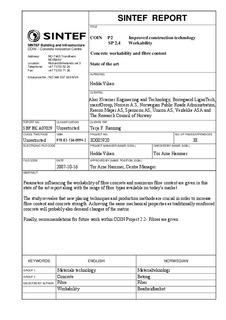| dc.contributor.author | Vikan, Hedda | |
| dc.date.accessioned | 2016-12-04T12:20:16Z | |
| dc.date.available | 2016-12-04T12:20:16Z | |
| dc.date.issued | 2007 | |
| dc.identifier.isbn | 978-82-536-0994-2 | |
| dc.identifier.uri | http://hdl.handle.net/11250/2424151 | |
| dc.description.abstract | Parameters influencing the workability of fibre concrete and maximum fibre content are given in this state of the art report along with the range of fibre types available on today’s market.
The study reveales that new placing techniques and production methods are crucial in order to increase fibre content and concrete strength. Achieving the same mechanical properties as traditionally reinforced concrete will probably also demand changes of the matrix.
Finally, recommendations for future work within COIN Project 2.2- Fibres are given. | |
| dc.description.sponsorship | The COIN industrial partners are: Aker Kværner Engineering and Technology, Borregaard LignoTech, maxitGroup, Norcem A.S, Norwegian Public Roads Administration, Rescon Mapei AS, Spenncon AS, Unicon AS and Veidekke ASA. | |
| dc.language | eng | |
| dc.publisher | SINTEF Building and Infrastructure; COIN - Concrete innovation Centre | |
| dc.relation.ispartofseries | SINTEF report;SBF BK A07029 | |
| dc.subject | Materials technology | |
| dc.subject | Concrete | |
| dc.subject | Fibre | |
| dc.subject | Workability | |
| dc.subject | Materialteknologi | |
| dc.subject | Betong | |
| dc.subject | Fiber | |
| dc.subject | Bearbeiderhet | |
| dc.title | Concrete workability and fibre content | |
| dc.type | Research report | |
| dc.description.version | publishedVersion | |
| dc.rights.holder | © SINTEF Byggforsk | |
| dc.subject.nsi | VDP::Technology: 500 | |
| dc.description.localcode | 3D005920 | |
